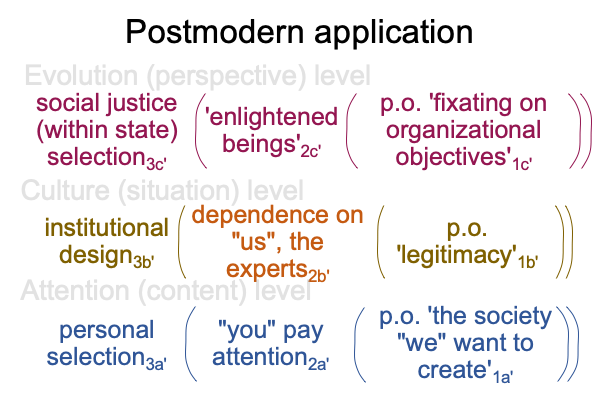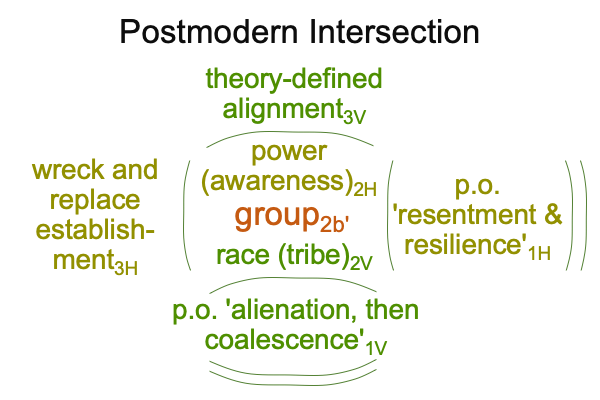0433 Here is another picture of the intersection for the band, during Era 1, lasting between 7 and 3.5Myr.

Am I joking?
Put “family, “friends” or “band” in for “interdependence2b“.
0433 With this in mind, I examine the remainder of chapter two, starting with the subheading, “Great Ape Cooperation”.
The LCA, typical of great apes, is built for competition within a band. Apes compete for food and nice places to nest. Male apes compete for female apes. Hierarchies get established and promote all sorts of Machiavellian cognitive traits. Did I say Machiavelli? Machiavelli titles one of his books, The Prince. Does that title sound like establishment3H or alliance3V? Hmmm, maybe it sounds like both. Alliances are more than friendships and grooming partnerships, they contribute to conflicts in which the hierarchy may be challenged. Alliances also diffuse the same conflicts.
0434 Machiavelli does not promote morality. He does not counsel justice and fairness. He promotes using the morality of others to advance one’s positional power.
0435 So, why would not everyone adopt Machiavellian principles?
One of the moments when Machiavellian individual intentionality does not apply occurs when one group (or band)threatens another. Such a crisis may destroy established powers2H and affiliations2V. An affirmation must be made. Yes, there is justice in having a place in the heirarchy1H. There is fairness in having others on my side1V. So, in times of war, the artifices2H,2V of Machiavellian propositions fall away, and the potentials1H,1V that culture selects for3b, supporting the actuality of our interdependence2b, show their adaptive potential1b.
0436 The group2b adapts into the niche of cooperation1b, the potential of joint attention2a, by practicing ways of livingwhere each member has a place in the hierarchies1H and has others on his and her side1V.
0437 The group2 is a mystery.
The natural history of morality entails the evolution of the purely relational structure that characterizes the presence underlying the word, “religion”.
0438 Once again, here is a picture of Tomasello’s vision.

0439 Okay, the following segment may seem to be a distraction.
Yes, from here to point 0443 constitutes a distraction.
Are there lessons here that apply to our current Lebenswelt?
Today, at the conclusion of the Age of Ideas, there are psychics, scientists and sociopaths who portray themselves as beings of greater awareness and enlightenment2c. These experts2c want to select3a for a new humanity1a.
On what basis?
0440 First, they2c consider all traditional civilized traditions2b to be social constructions, rather than evolved products of group selection.
Because they2c are devotees of postmodern science (which includes the natural and the social as well as the psychometric), they imagine that they can design3b novel establishments3H, based on their organizational objectives1c. These bureaucracies3H will replace current unscientific and superstition-filled institutions2b and denature countervailing reactionary groups2b.
In short, the most certified among us2c propose institutional selection3b based on a type of cooperation1b, defined as the potential1b of everyone paying attention2a to the society that they want to create1a.
Another name for that potential1b is “legitimacy1b“.
Here is a picture.

0441 Second, their organizational objectives1c critique all traditions2b on the bases of power2H and race2V. The term, “power”, entails an appointed position in any organization. The term, “race”, is code for “tribe”, where “tribe” is defined by adherence to a particular organizational objective1c.
Awareness1c of power2H is supported by a specific version of justice1H. Individuals belonging to any of the designated “races” or “tribes” do not have a home in the any traditional hierarchy1H, even though they may be appointed to long-established institutional positions. Fixation1c on power2H breeds resentment. Resentment creates what is called, “resilience”, the tenacity of knowing that the expert is righteous and others are not. James Corney calls it1H “a higher loyalty”.
Awareness1c of affiliation2V is supported by a particular version of fairness1V. Individuals belonging to opposing “races” or “tribes” (that is, people who do not ideate the revelations of the psychometric sciences) cannot be on the side1V of the expert-designated “races” or “tribes”. Fixation1c on affiliation2V breeds alienation1V (the conviction that the opposing “races” or “tribes” can never be fair, that is, “on my side”). Alienation is followed by coalescence1V into a theoretically defined “tribe”.
Here is a picture.

“Interdependence2b” transforms into “dependence on us, the experts2b“. But, both terms are too lengthy to fit into the above diagram.
So, the word, “group2b” must do.
0442 Third, awareness-driven fixation on organizational objectives1c mandates the authority of the state to act on behalf of the enlightened beings2c ,who embody the union of power2H and tribalism2V.
State-promulgated social justice3c promotes programs of mandatory inclusion1b of tribal members2H into established positions of authority2H (without an oath of loyalty) and demands the recognition of the legitimacy1b of the academic postulates3b that contextualize the theoretical construction of novel “races”2V. Indeed, to become an affiliate of any particular “tribe”2V, one must first suffer alienation followed by illumination1V.
0443 What am I talking about?
In order to see that Tomasello’s intersection of power2H and affiliation2V not only pertains to the era of individual intentionality, but also to the living world that academic elites currently strive to create, consider the blogs titled, Looking at Gad Saad’s Book (2020) “The Parasitic Mind”, by Razie Mah, appearing in the month of April, 2022.
